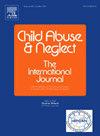Parent-teen concordance of selected adverse childhood experiences in a national sample of teenagers: Findings from National Health Interview Survey – Teen
IF 3.4
2区 心理学
Q1 FAMILY STUDIES
引用次数: 0
Abstract
Background
Parent-reported surveys are commonly used in child health research. However, few national surveys have examined concordance between parent- and teen-reported Adverse Childhood Experiences (ACEs).
Objective
To examine concordance between parent- and teen-reported ACEs among a nationally representative sample of teens and understand sociodemographic correlates of concordance.
Participants and setting
Data were collected as part of the National Health Interview Survey (NHIS), an annual nationally representative survey of the United States, with parent-reported interviews and its follow-back survey, the National Health Interview Survey-Teen (NHIS-Teen), a self-administered web survey of youth aged 12–17 years.
Methods
Parent- and teen-reported ACEs, and several measures of concordance (e.g. weighted Cohen's kappa, prevalence adjusted bias adjusted kappa (PABAK)) are presented. Unadjusted logistic regressions tested associations between sociodemographic characteristics and likelihood of concordance for each ACE.
Results
ACEs prevalence based on parent report were lower compared to teen report (e.g. victim of or witnessed violence in the neighborhood, 6.5 % parent-reported vs. 15.5 %, teen-reported). Weighted Cohen's kappa statistics showed fair to moderate agreement (ks ranging from 0.27 to 0.53), with PABAK statistics showing slightly higher levels (ks ranging from 0.41 to 0.88).
Conclusions
There is discordance in ACEs reporting between teens and their parents, with parents less likely to report that their teen experience an ACE than teens are. This emphasizes the importance of collecting information directly from teenagers, which may help inform intervention work.
在全国青少年样本中选择的不良童年经历的父母-青少年一致性:来自全国健康访谈调查-青少年的发现
背景:父母报告的调查通常用于儿童健康研究。然而,很少有全国性的调查检查了父母和青少年报告的不良童年经历(ace)之间的一致性。目的在全国具有代表性的青少年样本中检验父母和青少年报告的ace的一致性,并了解一致性的社会人口学相关性。参与者和背景数据是作为全国健康访谈调查(NHIS)的一部分收集的,这是一项具有美国全国代表性的年度调查,包括家长报告的访谈和后续调查,全国健康访谈调查-青少年(NHIS- teen),这是一项针对12-17岁青少年的自我管理的网络调查。方法介绍了父母和青少年报告的ace,以及几种一致性测量方法(如加权Cohen's kappa,患病率调整偏差调整kappa (PABAK))。未经调整的逻辑回归检验了社会人口学特征与每个ACE的一致性可能性之间的关联。结果基于父母报告的暴力发生率低于青少年报告(例如,父母报告的邻里暴力受害者为6.5%,青少年报告的邻里暴力受害者为15.5%)。加权Cohen's kappa统计数据显示出中等到中等的一致性(ks范围从0.27到0.53),PABAK统计数据显示出稍高的水平(ks范围从0.41到0.88)。结论青少年和他们的父母在ACE报告上存在不一致,父母比青少年更不可能报告他们的孩子经历过ACE。这强调了直接从青少年那里收集信息的重要性,这可能有助于告知干预工作。
本文章由计算机程序翻译,如有差异,请以英文原文为准。
求助全文
约1分钟内获得全文
求助全文
来源期刊

Child Abuse & Neglect
Multiple-
CiteScore
7.40
自引率
10.40%
发文量
397
期刊介绍:
Official Publication of the International Society for Prevention of Child Abuse and Neglect. Child Abuse & Neglect The International Journal, provides an international, multidisciplinary forum on all aspects of child abuse and neglect, with special emphasis on prevention and treatment; the scope extends further to all those aspects of life which either favor or hinder child development. While contributions will primarily be from the fields of psychology, psychiatry, social work, medicine, nursing, law enforcement, legislature, education, and anthropology, the Journal encourages the concerned lay individual and child-oriented advocate organizations to contribute.
 求助内容:
求助内容: 应助结果提醒方式:
应助结果提醒方式:


